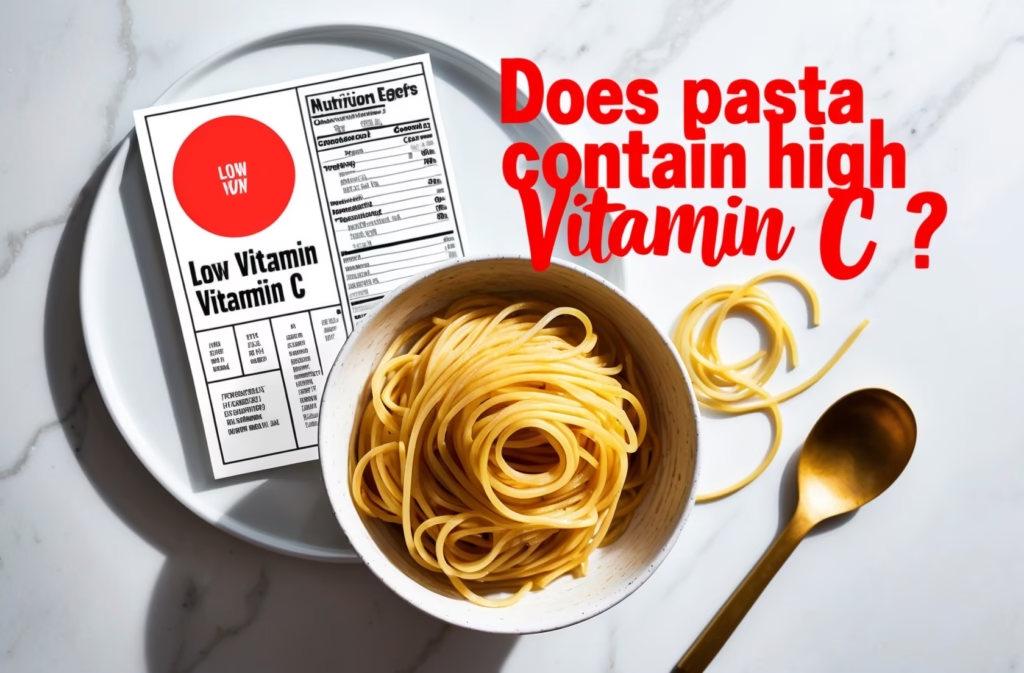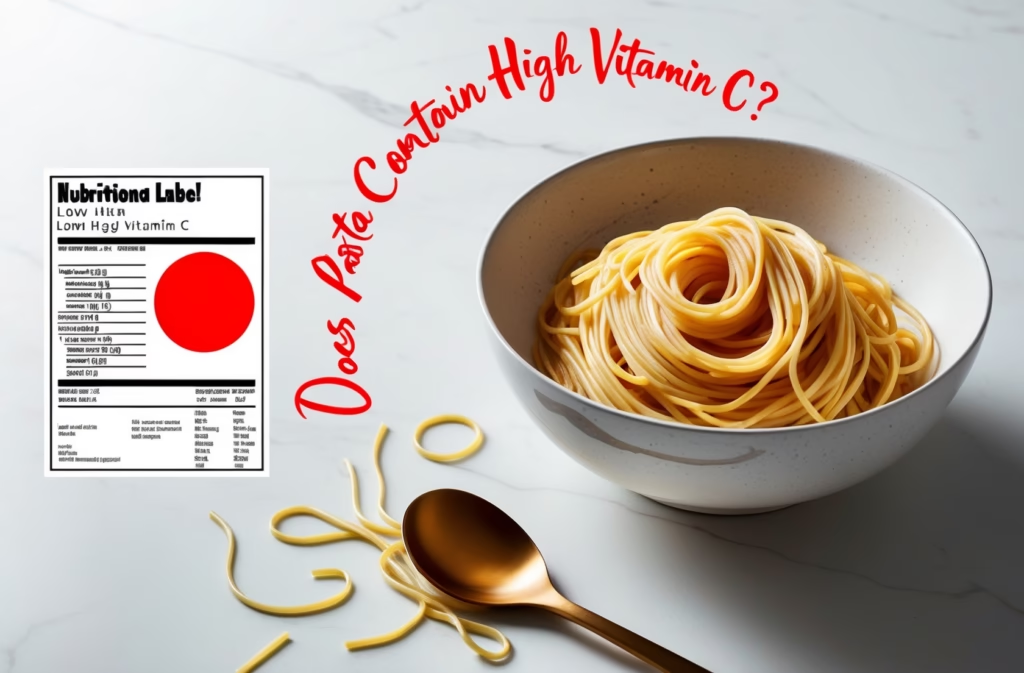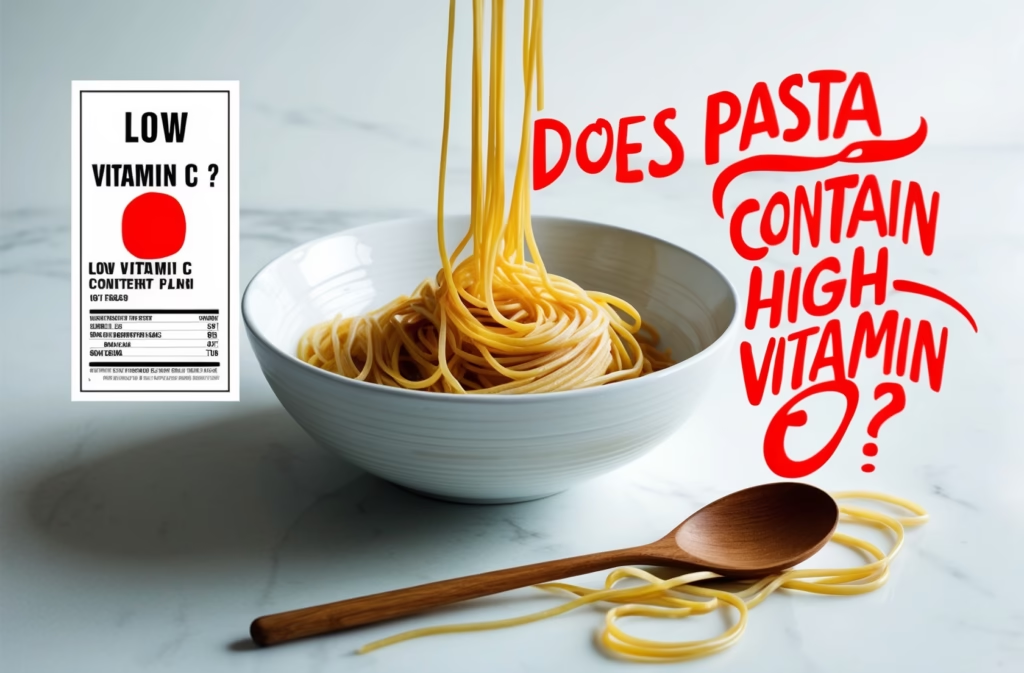Does Pasta Have High Vitamin C? Discover the truth about pasta’s Vitamin C content. Find out if pasta is a good source of Vitamin C in this informative article. Pasta Vitamin C Content explained!
Does Pasta Have High Vitamin C? Unraveling the Nutritional Truth
The question, Does pasta have high Vitamin C? is a common one, especially for those striving for a balanced diet. While pasta is a staple in many cuisines and provides carbohydrates for energy, its Vitamin C content is a different story. This article delves into the pasta Vitamin C content, exploring whether this beloved food contributes significantly to your daily Vitamin C intake.
Understanding Vitamin C and its Importance
Vitamin C, also known as ascorbic acid, is a crucial nutrient vital for numerous bodily functions. It’s a powerful antioxidant, protecting our cells from damage caused by free radicals. This antioxidant action plays a crucial role in preventing chronic diseases. Moreover, Vitamin C is essential for collagen production, crucial for maintaining healthy skin, bones, and blood vessels. It also boosts the immune system, helping us fight off infections. A deficiency in Vitamin C can lead to scurvy, a serious health condition characterized by fatigue, weakness, and bleeding gums.
Pasta Vitamin C Content: A Closer Look
The simple answer to Does pasta have high Vitamin C? is no. Plain pasta, whether it’s spaghetti, fettuccine, penne, or any other shape, is naturally low in Vitamin C. The refining process used to create pasta from wheat removes much of the wheat’s naturally occurring vitamins and minerals. This leaves the pasta primarily providing carbohydrates. The amount of Vitamin C in pasta is negligible compared to foods known for their high Vitamin C content such as citrus fruits, berries, and bell peppers.
Factors Influencing Vitamin C in Pasta Dishes
While plain pasta itself lacks significant Vitamin C, the overall Vitamin C content of a pasta dish can be boosted by the addition of other ingredients. For example, a vibrant pasta primavera laden with colorful vegetables like broccoli, bell peppers, and tomatoes will have a much higher Vitamin C content compared to a creamy Alfredo sauce based pasta dish. Similarly, including fresh herbs like parsley or basil also adds a touch of Vitamin C.
Consider the following examples:
- Penne alla Vodka: While delicious (Penne alla Vodka recipe), the Vitamin C content largely depends on the added ingredients. Tomatoes contribute some Vitamin C, but the cream significantly impacts the overall nutritional profile.
- Fettuccine Alfredo: (Fettuccine Alfredo recipe) This classic dish is notoriously low in Vitamin C, primarily due to the heavy cream and cheese sauce.
- Spaghetti Carbonara: The (Spaghetti Carbonara recipe) relies on eggs, cheese, and cured pork, all relatively low in Vitamin C.
- Tortellini in Brodo: (Tortellini in Brodo recipe) The broth might offer some minimal Vitamin C depending on the vegetables used in its preparation, but the overall Vitamin C content remains low.
- Linguine with Lobster: Although (Linguine with Lobster recipe) is a luxurious dish, lobster itself is not a significant source of Vitamin C.
Boosting Vitamin C Intake with Pasta Dishes
If you’re aiming to increase your Vitamin C intake while enjoying pasta, focus on the accompanying ingredients. Load your pasta dishes with Vitamin C-rich vegetables such as bell peppers (especially red ones), broccoli, spinach, tomatoes, and kale. Citrus fruits such as lemon or orange juice added to the sauce can also boost the Vitamin C level.
Comparing Pasta to Other Vitamin C Sources
To understand the Vitamin C in pasta context better, let’s compare it to some other significant Vitamin C sources. A single medium orange typically contains around 70 mg of Vitamin C, while a cup of chopped bell peppers can provide over 100 mg. On the other hand, a serving of plain pasta provides virtually no Vitamin C.
Exploring Whole Wheat Pasta Options
While not significantly high in Vitamin C, whole wheat pasta generally contains more nutrients than refined pasta, including a slightly higher amount of some vitamins and minerals. However, the increase in Vitamin C is minimal and won’t be a substantial source for your daily needs. The nutritional value of whole wheat pasta is still overshadowed by dedicated sources of Vitamin C.
The Importance of a Balanced Diet
Remember, relying on any single food source for all your nutritional needs is not recommended. A balanced diet with a variety of fruits, vegetables, whole grains, and lean proteins is crucial for optimal health. Including various Vitamin C-rich foods throughout the day, rather than solely depending on pasta, ensures that you meet your daily Vitamin C requirement.
Additional Resources
For more detailed information on Vitamin C and its role in health, you can refer to the following resources:
National Institutes of Health Office of Dietary Supplements – This website offers in-depth information on Vitamin C, including recommended daily allowances and potential deficiency symptoms.
Mayo Clinic – The Mayo Clinic website provides reliable and well-researched information on various health topics, including vitamins and nutrition.
Conclusion: Does Pasta Have High Vitamin C?
In conclusion, the answer to Does pasta have high Vitamin C? is a clear no. While pasta is a convenient and tasty carbohydrate source, it is not a significant contributor to your daily Vitamin C intake. To ensure adequate Vitamin C levels, incorporate a variety of fruits and vegetables rich in Vitamin C into your diet. Remember that a balanced and varied diet is key to maintaining good health and well-being. Your pasta dishes can definitely incorporate nutritious vegetables to increase overall nutritional value.
Share Your Experience!
Have you tried incorporating more Vitamin C-rich ingredients into your pasta dishes? Share your experience and favorite recipes in the comments below! Let’s discuss pasta Vitamin C content and how we can make our favorite dishes even healthier. What are your go-to sources of Vitamin C in Pasta dishes or your favorite Vitamin C rich food?

Frequently Asked Questions: Does Pasta Have High Vitamin C?
- Does pasta have any Vitamin C?
- No, pasta generally does not contain significant amounts of Vitamin C. The Vitamin C in pasta is negligible.
- Why is there little to no Vitamin C in pasta?
- Pasta is primarily made from refined grains (wheat). The refining process removes the bran and germ, which contain most of the vitamins and minerals, including Vitamin C. Therefore, the Pasta Vitamin C content is very low.
- Does the type of pasta affect its Vitamin C content?
- While some whole wheat pasta may contain slightly more nutrients than refined pasta, the amount of Vitamin C remains insignificant. The difference is not substantial enough to make a noticeable impact on your Vitamin C intake.
- Is there a way to increase the Vitamin C content of pasta?
- Adding a Vitamin C-rich sauce or topping to your pasta dish is the best way to increase your Vitamin C intake. The pasta itself won’t contribute significantly.
- Does Does Pasta Have Haigh Vitamin C affect its nutritional value?
- The lack of Vitamin C in pasta doesn’t negate its other nutritional benefits, such as carbohydrates for energy. However, it highlights the importance of consuming other Vitamin C-rich foods.
- What are some good sources of Vitamin C to eat with pasta?
- Pair your pasta with foods like bell peppers, tomatoes, broccoli, or citrus fruits to boost your Vitamin C intake.
- Is whole wheat pasta a good source of Vitamin C?
- While whole wheat pasta is generally more nutritious than refined pasta, it still does not provide a significant amount of Vitamin C. Its improved nutritional profile comes from other vitamins and minerals.
- How much Vitamin C is in a typical serving of pasta?
- The Pasta Vitamin C content in a typical serving is so low it’s considered negligible, practically zero. You won’t get any meaningful amount of Vitamin C from eating pasta.
- Does adding Vitamin C to the pasta water increase the Vitamin C in the pasta?
- No, adding Vitamin C to the cooking water won’t significantly increase the Vitamin C content of the pasta itself. Vitamin C is water-soluble and isn’t absorbed into the pasta during cooking.
- Should I be concerned about the lack of Vitamin C in pasta?
- Not necessarily. Pasta is a source of carbohydrates, but it’s crucial to obtain Vitamin C from other foods as part of a balanced diet. Focus on other foods for your Vitamin C intake rather than relying on pasta. The answer to Does Pasta Have Haigh Vitamin C? is simply no.

Does Pasta Have High Vitamin C? Unraveling the Nutritional Truth
The question, Does pasta have high Vitamin C? is a common one, especially for those focused on healthy eating. The short answer is: no, pasta itself doesn’t contain a significant amount of Vitamin C. Understanding the Pasta Vitamin C Content is crucial for balanced meal planning. This detailed blog post will delve into the specifics of Vitamin C in Pasta, exploring why it’s low and how you can incorporate this nutrient into pasta dishes.
The Vitamin C Content Mystery: Why Pasta Isn’t a Vitamin C Powerhouse
Pasta, primarily made from refined wheat flour and water, lacks the natural vitamins and minerals found in many fruits and vegetables. During the refinement process, the outer layers of the wheat grain, which contain much of the fiber and vitamins, are removed. This leaves the refined flour, which is then used to make pasta, significantly lower in micronutrients, including Vitamin C. While some whole-wheat pasta options might offer slightly higher levels of some nutrients, the Vitamin C content remains relatively low compared to Vitamin C-rich foods like citrus fruits, berries, and bell peppers.
This doesn’t mean pasta is inherently unhealthy. It can be a part of a balanced diet, but it shouldn’t be relied upon as a primary source of Vitamin C. Consider incorporating Vitamin C-rich ingredients into your pasta dishes to create a more nutritious meal. Think of adding a vibrant side salad with bell peppers and leafy greens, or incorporating chopped tomatoes into your sauce. For a richer, creamy pasta, try Fettuccine Alfredo, but remember to add your Vitamin C boost separately!
Boosting Vitamin C in Your Pasta Creations
The key to enjoying pasta as part of a healthy, Vitamin C-rich diet lies in strategic pairings. Instead of relying solely on the pasta itself for nutritional value, focus on complementing your meal with Vitamin C-rich foods. For instance, a simple dish of Spaghetti Carbonara can be enhanced with a side of steamed broccoli or a fresh salad with orange segments. The possibilities are endless!
Here are some creative ways to boost the Vitamin C content of your pasta meals:
- Add colorful vegetables: Incorporate bell peppers, broccoli, spinach, or tomatoes into your pasta sauce or as a side dish. These vegetables are excellent sources of Vitamin C.
- Citrus zest: A little zest of lemon or orange can add a burst of flavor and a significant amount of Vitamin C to your pasta sauce.
- Vitamin C-rich pesto: Create a pesto using parsley, a great source of Vitamin C, along with traditional basil and pine nuts.
- Fruit salad accompaniment: Serve a refreshing fruit salad alongside your pasta for a simple way to boost your Vitamin C intake. Berries, kiwi, and oranges are all great choices.
Pasta Dishes and their Nutritional Value
Let’s look at the nutritional profiles of some popular pasta dishes, keeping in mind that the Vitamin C content will largely depend on the accompanying ingredients. For example, a simple Penne Alla Vodka will have low Vitamin C unless you add vegetables. Conversely, a Linguine with Lobster can get some Vitamin C from the lobster, though it will be a negligible amount compared to direct Vitamin C sources. Tortellini in Brodo, a classic Italian soup, lacks Vitamin C unless you add a substantial amount of vegetables or citrus.
To understand the Pasta Vitamin C content fully, it’s crucial to consider the overall nutritional composition of your meal. Remember to add other foods rich in Vitamin C to compensate for pasta’s lack of this important nutrient.
Understanding the Importance of Vitamin C
Vitamin C, also known as ascorbic acid, is an essential nutrient vital for numerous bodily functions. It acts as a powerful antioxidant, protecting cells from damage caused by free radicals. Vitamin C also plays a crucial role in collagen production, wound healing, and immune system function. A deficiency in Vitamin C can lead to scurvy, characterized by fatigue, bleeding gums, and skin problems. The recommended daily intake of Vitamin C varies depending on age and other factors, making it important to consult with a healthcare professional or registered dietitian for personalized guidance.
For more information on the importance of Vitamin C and its role in health, you can consult reliable sources such as the National Institutes of Health (NIH): NIH Vitamin C Fact Sheet and the Mayo Clinic: Mayo Clinic – Vitamin C. These sources provide comprehensive information on Vitamin C’s benefits and recommended intake.
Recipe: Pasta Primavera with a Vitamin C Boost
This recipe focuses on maximizing the Vitamin C content in your pasta dish through the addition of colorful vegetables. The recipe serves 4.
Ingredients:
- 8 oz pasta (penne, rotini, or your favorite shape)
- 1 red bell pepper, chopped
- 1 yellow bell pepper, chopped
- 1 cup broccoli florets
- 1/2 cup cherry tomatoes, halved
- 1/4 cup chopped fresh parsley
- 2 cloves garlic, minced
- 2 tablespoons olive oil
- Salt and pepper to taste
- 1/4 cup grated Parmesan cheese (optional)
Instructions:
- Cook the pasta according to package directions until al dente.
- While the pasta cooks, heat the olive oil in a large skillet over medium heat.
- Add the garlic and cook for about 1 minute until fragrant.
- Add the bell peppers and broccoli and cook for 5-7 minutes, or until tender-crisp.
- Stir in the cherry tomatoes and cook for another 2 minutes.
- Drain the pasta and add it to the skillet with the vegetables.
- Stir in the parsley, salt, and pepper.
- Serve immediately, topped with Parmesan cheese (optional).
Nutrition Table (per serving):
| Nutrient Name | Amount per Serving | Daily Value (%) |
|---|---|---|
| Calories | 350 | 17.5 |
| Protein | 10g | 20 |
| Total Fat | 12g | 18.5 |
| Saturated Fat | 2g | 10 |
| Unsaturated Fat | 10g | – |
| Trans Fat | 0g | – |
| Cholesterol | 0mg | 0 |
| Total Carbohydrate | 55g | 18.3 |
| Dietary Fiber | 5g | 20 |
| Total Sugars | 5g | – |
| Vitamin C | 50mg | 55.5 |
| Calcium | 100mg | 10 |
| Iron | 3mg | 16.6 |
(Note: These values are estimates and may vary depending on the specific ingredients used.)
Summary:
While pasta itself is low in Vitamin C, you can easily enhance its nutritional value by incorporating Vitamin C-rich ingredients into your dishes. This pasta primavera recipe provides a delicious and convenient way to enjoy pasta while boosting your Vitamin C intake. Remember to consider the overall nutritional profile of your meal and pair your pasta with a variety of fruits and vegetables to achieve a balanced and healthy diet.
Call to Action:
Ready to make this delicious and healthy pasta dish? Try our Vitamin C-boosting Pasta Primavera recipe today! Share your culinary creations and experience on social media using #PastaPrimavera and #VitaminCPasta. Don’t forget to leave a comment below – we’d love to hear how your dish turned out! Let’s create a vibrant and nutritious pasta revolution together!

Does Pasta Have Vitamin C?
Pasta, a staple in many cuisines, is a source of carbohydrates providing energy. However, it’s not a significant source of Vitamin C. Unlike many fruits and vegetables, pasta, whether it’s delicious penne alla vodka like this recipe: penne alla vodka, creamy fettuccine Alfredo fettuccine Alfredo, or rich spaghetti carbonara spaghetti carbonara, is naturally low in Vitamin C. This means relying solely on pasta for your Vitamin C intake is not advisable.
The Vitamin C content of pasta depends primarily on the type of flour used and any added ingredients. Whole wheat pasta might contain slightly more vitamins and minerals than refined pasta but the increase in Vitamin C is negligible. To ensure you get enough Vitamin C, you need to incorporate other foods into your diet.
Many pasta dishes, however, include ingredients rich in Vitamin C. For instance, a vibrant tomato sauce in your penne alla vodka adds Vitamin C. Similarly, if you choose a lighter pasta dish such as tortellini in brodo, the vegetable broth could contribute some Vitamin C, though again, not in high quantities. Other dishes like linguine with lobster could have Vitamin C depending on the added vegetables.
Health Considerations: Vitamin C is crucial for immune function, collagen production, and iron absorption. A deficiency can lead to scurvy, though this is rare in developed countries. To ensure adequate Vitamin C intake, focus on fruits and vegetables such as citrus fruits, berries, bell peppers, and leafy greens. Incorporate these Vitamin C-rich foods alongside your pasta meals for a balanced and healthy diet. Remember, a varied and balanced diet is key to overall health.
Practical Tips: Don’t rely on pasta as your primary source of Vitamin C. Pair your pasta dishes with vegetables like broccoli, spinach, or peppers. Add a side salad with a citrus vinaigrette. Consider including fruits like oranges or strawberries as part of your meal or as a snack.